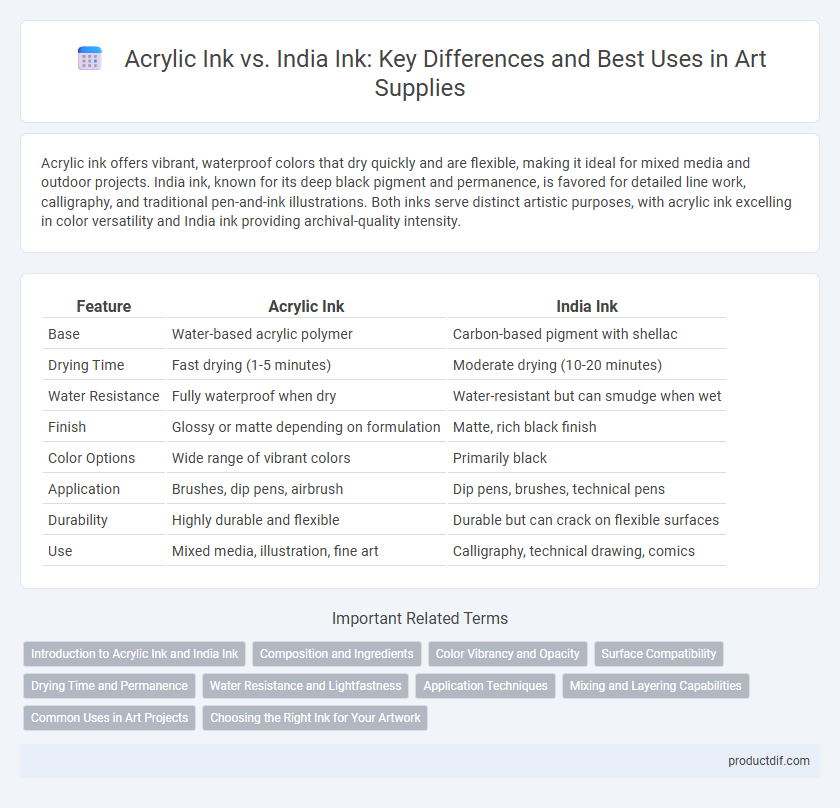Acrylic ink offers vibrant, waterproof colors that dry quickly and are flexible, making it ideal for mixed media and outdoor projects. India ink, known for its deep black pigment and permanence, is favored for detailed line work, calligraphy, and traditional pen-and-ink illustrations. Both inks serve distinct artistic purposes, with acrylic ink excelling in color versatility and India ink providing archival-quality intensity.
Table of Comparison
| Feature | Acrylic Ink | India Ink |
|---|---|---|
| Base | Water-based acrylic polymer | Carbon-based pigment with shellac |
| Drying Time | Fast drying (1-5 minutes) | Moderate drying (10-20 minutes) |
| Water Resistance | Fully waterproof when dry | Water-resistant but can smudge when wet |
| Finish | Glossy or matte depending on formulation | Matte, rich black finish |
| Color Options | Wide range of vibrant colors | Primarily black |
| Application | Brushes, dip pens, airbrush | Dip pens, brushes, technical pens |
| Durability | Highly durable and flexible | Durable but can crack on flexible surfaces |
| Use | Mixed media, illustration, fine art | Calligraphy, technical drawing, comics |
Introduction to Acrylic Ink and India Ink
Acrylic ink is a fast-drying, water-resistant pigment-based medium known for its vibrant colors and versatility on surfaces like canvas, paper, and wood. India ink, traditionally made from carbon black and a binder like shellac, offers deep, rich blacks and has been favored for calligraphy and detailed line work due to its permanence and smooth flow. Artists choose acrylic ink for bold, layered effects while India ink excels in precision and archival quality.
Composition and Ingredients
Acrylic ink consists of pigment particles suspended in an acrylic polymer emulsion, providing waterproof and lightfast qualities when dry, ideal for vibrant, durable artwork. India ink is composed primarily of carbon black pigment mixed with a water-soluble binder like shellac or gelatin, offering deep black tones with quick drying but less flexibility and water resistance. Differences in composition affect their performance, with acrylic ink being more versatile for mixed media and archival projects, while India ink is favored for traditional pen and brush illustration.
Color Vibrancy and Opacity
Acrylic ink offers superior color vibrancy with its waterproof, lightfast pigments that maintain brightness over time, making it ideal for vivid artwork. India ink, traditionally made from carbon black, provides deep, rich opacity but lacks the color range and intensity of acrylic inks. The choice between acrylic ink and India ink depends on the desired effect, with acrylic ink excelling in saturated, colorful compositions and India ink favored for bold, opaque black lines.
Surface Compatibility
Acrylic ink adheres effectively to a wide range of surfaces including canvas, wood, glass, and fabric due to its flexible and water-resistant properties. India ink is best suited for smooth, non-porous surfaces like paper, illustration boards, and vellum, offering deep black pigmentation and precise line work. Surface compatibility is crucial when choosing between acrylic ink and India ink to ensure durability and desired visual effects in art projects.
Drying Time and Permanence
Acrylic ink dries significantly faster than India ink, typically within 10-15 minutes, making it ideal for quick layering and fast-paced projects. India ink, known for its slow drying time of up to several hours, allows for smoother blending and detailed work before setting permanently. Both inks offer excellent permanence, but acrylic ink is waterproof once dry, while traditional India ink is often water-resistant but can smudge if exposed to moisture without sealing.
Water Resistance and Lightfastness
Acrylic ink offers superior water resistance compared to India ink, making it ideal for mixed media projects exposed to moisture. India ink, while water-resistant once dry, can smudge or bleed if not sealed, limiting its use in water-exposed artworks. Lightfastness varies by brand, but acrylic inks generally provide enhanced UV stability, ensuring vibrant, long-lasting colors over time.
Application Techniques
Acrylic ink offers versatility for layering, blending, and wash techniques due to its fast-drying, water-resistant properties, making it ideal for mixed media projects and detailed brushwork. India ink, known for its rich, intense black pigment, excels in calligraphy, drawing, and fine line work with a smooth, permanent finish that resists fading and water. Artists often choose acrylic ink for vibrant, translucent effects and India ink for precision and archival-quality illustrations.
Mixing and Layering Capabilities
Acrylic ink offers superior mixing and layering capabilities due to its fast drying time and permanent waterproof finish, enabling artists to build vibrant, translucent layers without smudging. India ink, traditionally made from carbon black pigment and water, excels in creating rich, opaque lines but tends to reactivate when wet, limiting seamless layering and blending. For projects requiring dynamic color mixing and durable layered effects, acrylic ink provides greater flexibility and control compared to the more limited reworking potential of India ink.
Common Uses in Art Projects
Acrylic ink is favored for vibrant, waterproof artwork suited to mixed media, calligraphy, and illustration, offering fast drying times and strong adhesion on various surfaces. India ink, known for its rich black pigment and archival quality, is commonly used in traditional drawing, inking comics, and detailed line work requiring precision and longevity. Artists often choose acrylic ink for color versatility and moisture resistance, while India ink remains preferred for monochromatic, fine-detail projects and archival documentation.
Choosing the Right Ink for Your Artwork
Acrylic ink offers vibrant, water-resistant colors with fast drying times, making it ideal for dynamic, mixed-media artwork and surfaces like canvas and paper. India ink provides rich, deep blacks with excellent permanence and smooth flow, preferred for detailed line work and traditional pen-and-ink styles on paper. Selecting the right ink depends on your desired texture, surface compatibility, and drying preferences to ensure longevity and the desired visual effect.
Acrylic Ink vs India Ink Infographic

 productdif.com
productdif.com